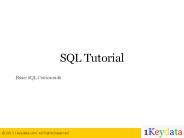SQL%20Tutorial - PowerPoint PPT Presentation
Title:
SQL%20Tutorial
Description:
SQL Tutorial Introduction to Database Learning Objectives Read and write Data Definition grammar of SQL Read and write data modification statements (INSERT, UPDATE ... – PowerPoint PPT presentation
Number of Views:975
Avg rating:3.0/5.0
Title: SQL%20Tutorial
1
SQL Tutorial
- Introduction to Database
2
Learning Objectives
- Read and write Data Definition grammar of SQL
- Read and write data modification statements
- (INSERT, UPDATE, DELETE)
- Read and write basic SELECT FROM WHERE queries
- Use aggregate functions
3
Part1 SQL used for Data Definition
- Allows the specification of not only a set of
relations but also information about each
relation, including - The schema for each relation
- The domain of values associated with each
attribute - Integrity constraints
4
Domain Types in SQL
Type Description
CHAR(n) Fixed length character string, with specified length n
VARCHAR(n) Variable length character string, with specified maximum length n
INTEGER Integer (a machine-dependent finite subset of the integers)
SMALLINT(n) A small integer (a finite subset of INTEGER)
FLOAT(M,D) Floating point number, with total number of digits M and number of digits following the decimal point D
DOUBLE(M,D) Double-precision floating point number
- Similar to data types in classical programming
languages
5
CREATE DATABASE
- An SQL relation is defined using the CREATE
DATABASE command - create database database name
- Example
- create database mydatabase
6
CREATE TABLE
- An SQL relation is defined using the CREATE TABLE
command - Create table tablename (A1 T1,A2 T2, An Tn,
- (integrity-constraint1),
- ,
- (integrity-constraintk))
- Each Ai is an attribute name in the table
- Each Ti is the data type of values for Ai
- Example
- Create table student
- (flashlineID char(9) not null,
- name varchar(30),
- age integer,
- department varchar(20),
- primary key (flashlineID) )
Integrity constraint
7
DROP and ALTER TABLE
- The DROP TABLE command deletes all information
about the dropped relation from the database - The ALTER TABLE command is used to add attributes
to or remove attributes from an existing relation
(table) - alter table tablename actions
- where actions can be one of following actions
- ADD Attribute
- DROP Attribute
- ADD PRIMARY KEY (Attribute_name1,)
- DROP PRIMARY KEY
8
Part2 Modifying the database
- 3 basic cases
Add a tuple INSERT INTO table_name VALUES (Val1, Val2, , Valn)
Change tuples UPDATE table_name SET A1val1, A2val2, , Anvaln WHERE tuple_selection_predicate
Remove tuples DELETE FROM table_name WHERE tuple_selection_predicate
9
INSERTION
- Add a new tuple to student
- insert into student
- values(999999999,Mike,18,computer
science) - or equivalently
- insert into student(flashlineID,name,age,departm
ent) - values(999999999,Mike,18,computer
science) - Add a new tuple to student with age set to null
- insert into student
- values(999999999,Mike,null,computer
science)
10
UPDATE
- Set all department to computer science
- update student
- set departmentcomputer science
- In table account(account_number, balance,
branch_name, branch_city), increase the balances
of all accounts by 6 - update account
- set balancebalance1.06
11
DELETION
- Delete records of all students in the university
- delete from student
- Delete the students who study computer science
- delete from student
- where departmentcomputer science
12
Part3 Basic Query Structure
- A typical SQL query has the form
- select A1, A2, , An
- from table1, table2, , tablem
- where P
- Ai represents an attribute
- tablei represents a table
- P is a constraints (condition)
- This query is equivalent to the relational
algebra expression - Example
- Select flashlineID, name from student
- Where departmentcomputer science
13
The SELECT Clause Duplicate tuples
- Unlike pure relational algebra, SQL does not
automatically remove duplicate tuples from
relations or query results - To eliminate duplicates, insert the keyword
distinct after select. - Example Find the names of all students in the
university, and remove duplicates - select distinct name
- from student
14
The SELECT Clause Expressions, as
- An star in the select clause denotes all
attributes - select from student
- An expression can be assigned a name using as
- Example
- select FlashlineID as ID
- from student
- Note as is rename clause, also can be used to
rename table name - select name as myname
- from student as S
15
The WHERE Clause
- The WHERE clause specifies the conditions
(constraints) results satisfy - Corresponds to the selection predicate s
- Comparisons and Booleans are as follows
- Comparison operator lt, lt, gt,gt, , ltgt
- Logical operators and, or, not
- Example
- Find names of all students in computer science
department with age smaller than 18 - select names
- from student
- where departmentcomputer science and agelt18
16
Aggregate Functions
- Aggregate functions operate on the multiset of
values of a attribute and return a value - avg(attribute) average value
- min(attribute) minimum value
- max(attribute) maximum value
- sum(attribute) sum of values
- count(attribute) number of values
- To obtain the value when duplicates are removed,
insert the keyword distinct before attribute
name - avg(distinct attribute)
17
Aggregation GROUP BY clause
- GROUP BY attribute operate in this sequence
- Groups the attribute sets members into subsets
by value - Performs the aggregate separately on each subset
- Produces a result value for each subset
- Example list each department and its number of
students - select department, count(distinct name) as
number - from student
- group by department
- Note if a select clause contains any aggregate
functions, then all non-aggregated terms in the
select clause must be used in a group by clause.
Ex department is not aggregated, so it must be
in the group by clause.
18
Null Values and Aggregate
- The youngest student in the university
- select
- from student
- where agemin(age)
- Above statement ignores null amounts
- Result is null if there is no non-null amount
- All aggregate operations except count() ignore
tuples with null values on the aggregated
attributes.































